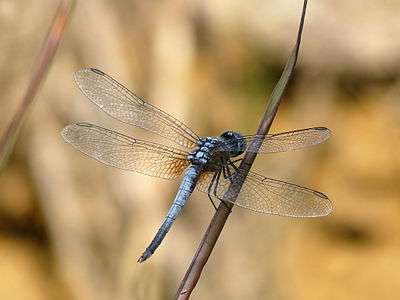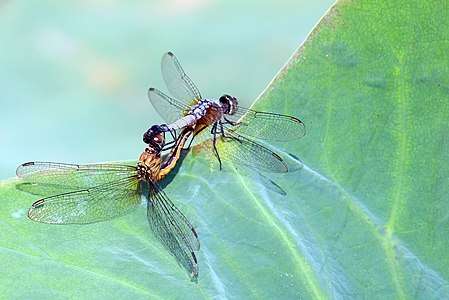Brachydiplax chalybea
Brachydiplax chalybea[2] is a species of dragonfly in the family Libellulidae. It is known by the common names yellow-patched lieutenant,[3] rufous-backed marsh hawk,[4][5] and blue dasher.[6] It is native to much of eastern Asia, from India to Japan to Indonesia.[1][7]
| Brachydiplax chalybea | |
|---|---|
 | |
| Male | |
 | |
| Female | |
| Scientific classification | |
| Kingdom: | |
| Phylum: | |
| Class: | |
| Order: | |
| Family: | |
| Genus: | |
| Species: | B. chalybea |
| Binomial name | |
| Brachydiplax chalybea (Brauer, 1868) | |
| Synonyms | |
| |
Description and habitat
The male of the species is 33 to 35 millimeters long and has a hindwing 24 to 27 millimeters long. It is powder blue with light brown sides and a dark tip to the abdomen. Wings are hyaline, with tinted burnt-brown base, fading to amber. The female is brownish yellow in color with darker markings along the dorsal abdomen. Its wings lack the yellow tinge. This species can be easily distinguished from other species in this genus by its larger size, characteristic colour of the thorax, and bases of wings.[6][8][9][4][5]
 Mating
Mating Egg laying
Egg laying
This species is found in many types of wet habitat, including brackish and disturbed waters.[1] The males are seen more often, due to their territorial behavior. Females oviposit by "flicking" an egg mass out of the water into rocks and vegetation nearby.[6]
See also
- List of odonates of Sri Lanka
- List of odonates of India
- List of odonata of Kerala
References
- Dow, R.A. (2010). "Brachydiplax chalybea". IUCN Red List of Threatened Species. 2010: e.T167148A6308602.
- Martin Schorr; Dennis Paulson. "World Odonata List". University of Puget Sound. Retrieved 12 Oct 2018.
- Cheong, L. F., Lua, H. K., & Murphy, D. H. (2008). The dragonflies (Odonata) of Singapore: Current status records and collections of the Raffles Museum of Biodiversity Research. Archived 2016-03-08 at the Wayback Machine Raffles Museum of Biodiversity Research, National University of Singapore.
- "Brachydiplax chalybea Brauer, 1868". India Biodiversity Portal. Retrieved 2017-03-17.
- "Brachydiplax chalybea Brauer, 1868". Odonata of India, v. 1.00. Indian Foundation for Butterflies. Retrieved 2017-03-17.
- Brachydiplax chalybea. Digital Nature Archive of Singapore, Lee Kong Chian Natural History Museum.
- K.A., Subramanian; K.G., Emiliyamma; R., Babu; C., Radhakrishnan; S.S., Talmale (2018). Atlas of Odonata (Insecta) of the Western Ghats, India. Zoological Survey of India. pp. 306–307. ISBN 9788181714954.
- C FC Lt. Fraser (1936). The Fauna of British India, including Ceylon and Burma, Odonata Vol. III. Red Lion Court, Fleet Street, London: Taylor and Francis. pp. 328–329.
- Subramanian, K. A. (2005). Dragonflies and Damselflies of Peninsular India - A Field Guide.
External links
![]()
![]()
